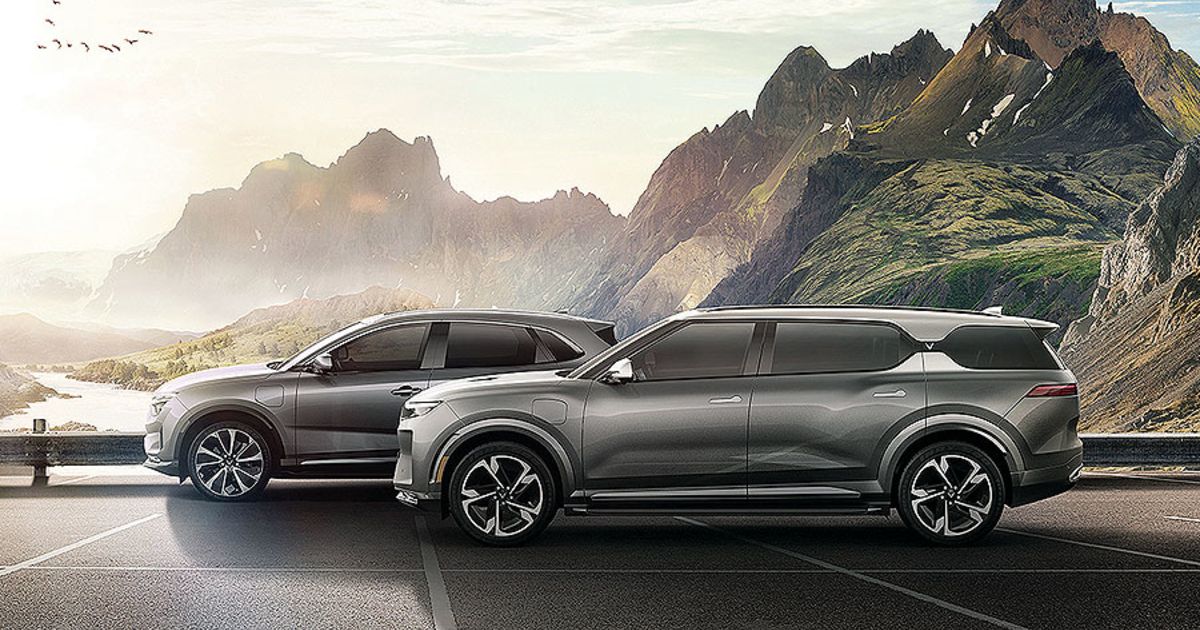
Vietnamese automaker VinFast is taking a page from technology startups in its approach to launching a line of electric vehicles in the U.S., beginning with two premium crossovers this year. That means big product promises, a breakneck timeline for mass production and the risk of failing fast.
The young automaker, which just delivered its first gasoline-powered vehicle in 2019, made its biggest commitment yet to the U.S. market last week with a preliminary agreement to build assembly and battery factories at a North Carolina industrial park. U.S. production is planned for mid-2024.
The factory plan comes after VinFast showed two electric prototypes at the Los Angeles Auto Show in November, followed by three more models at CES in January. Preorders for its Vietnam-made VF 8 and VF 9 crossovers began in January for delivery this year. VinFast is also expanding to Canada and Europe.
“The project in North Carolina affirms VinFast’s commitment in investing and developing business in its international markets in general and the U.S. in particular,” VinFast said in a statement last week. “It will also ensure VinFast’s self-reliance in global manufacturing.”
While the aggressive rollout could help VinFast capture a chunk of the early-adopter EV market emerging in the U.S., the approach comes with peril, analysts say. Homegrown U.S. startups such as Lordstown Motors and Canoo are struggling to survive, even before delivering their first vehicles.
Even the well-funded and highly regarded EV newcomers Rivian and Lucid have slashed production estimates this year because of the global semiconductor shortage and growing pains with parts suppliers.
And VinFast’s corporate parent, Vietnamese conglomerate Vingroup, recently backed out of a separate international expansion project.
Vingroup pulled the plug last year on its smartphone venture VinSmart after just three years. Vingroup said it was shuttering VinSmart to focus all of its resources on VinFast.
VinSmart captured significant market share in Vietnam and briefly exported smartphones to the U.S. before throwing in the towel.
“VinFast is taking an extremely aggressive approach to selling cars in the U.S.,” said Karl Brauer, executive analyst at iSeeCars.com. “But despite all the activity, I’m not convinced they’ll find the same success as brands like Hyundai and Kia.”
Hyundai came to the U.S. in 1986 and Kia in 1992.
“Even if they have cars to sell and a local facility to build them, they still have to face the massive retailing challenge that comes with selling cars in the U.S. market,” Brauer said. “For VinFast, that will be an issue, even assuming everything else, including production, certification and awareness, all move forward without any unexpected issues. And that’s a big assumption.”
VinFast told Automotive News last week that it has about 55,000 orders for the VF 8 and VF 9 in the U.S., Canada, France, Germany, Netherlands and Vietnam.
The automaker did not give a breakout for the U.S., where it will sell the vehicles directly to consumers.
The automaker has said that it is considering an initial public offering to raise funds, but it will use its own funds to start construction in North Carolina.
In response to questions from Automotive News last week, the automaker added: “VinFast will announce any future plans at the appropriate time.”
Car shoppers will get their first opportunity to ride in preproduction versions of the VF 8 and VF 9 at the New York auto show this month, a VinFast spokesperson said. Production vehicles will arrive in a few months.
VinFast has provided a brief overview of the two-row VF 8 and the three-row VF 9. Both were designed by Italian firm Pininfarina.
Inside, they employ a Tesla-style 15.6-inch touch screen, minimizing the use of physical buttons.
The VF 8 will have 402 hp and accelerate to 60 mph in 5.5 seconds. The automaker estimates the five-seat crossover’s range at 317 miles, based on the Worldwide Harmonized Light Vehicles Test Procedure used in Europe. The U.S. EPA range test generally results in lower numbers.
The three-row VF 9 has the same horsepower as its smaller sibling, and VinFast estimates acceleration to 60 mph at 6.5 seconds. Its range is estimated at 423 miles on the WLTP test.
VinFast announced at CES that pricing for the VF 8 would start at $41,000, excluding the battery, which must be leased. Pricing for the VF 9 will start at $56,000, also excluding the battery.
The automaker plans to rent batteries to customers at a price similar to a monthly gasoline expense — about $100 to $150 a month, depending on the battery chosen, according to Le Thi Thu Thuy, the company’s newly appointed global CEO.
But understanding the leasing plan of an already unknown brand could be a stumbling block for consumers, said Stephanie Brinley, principal automotive analyst at IHS Markit.
“VinFast will be challenged by needing to raise, first, consumer awareness and then consumer consideration,” Brinley said.
“For consumers who already intend to make an EV their next purchase, it’s a little too soon to tell if the battery-leasing scheme will prove attractive or confusing.”
VinFast also will be entering a U.S. EV market that will include dozens of new models from Ford, General Motors, Toyota, Hyundai, Honda and every luxury brand in the next few years. Brinley thinks the U.S. market initially will have more EV supply than demand, further complicating VinFast’s path to success.
“However, VinFast has commitment, ambition and funding, and it is not afraid to move very quickly,” Brinley added. “VinFast has proven it has speed and agility and a certain fearlessness.
“But we will see if it also has the patience necessary to grow U.S. volumes,” she said, “including enough to support the 150,000-unit plant they just announced.”